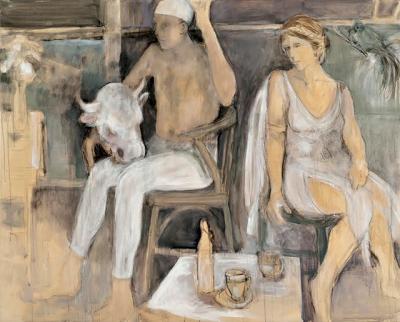Painting Through Art History

It’s not too surprising to see that Susan Ecker spent an extra year studying art history after receiving her M.F.A. in drawing and painting. Her subject matter teems with classical, neo-classical, and postmodern references in the show now on view at the Peter Marcelle Project in Southampton.
It opens with a beautiful piece in paint and mixed media, what looks like a blend of crayon and pastel with oil. Called “Rembrandt’s Women,” it hints at female bathing figures, but they are faded and ghost-like, overwhelmed by a variety of deeply jewel-toned plant life. The calling out of Rembrandt in such a pretty and feminine treatment plays with expectations and announces that the artist has made the old master’s subject matter her own.
The figures and presumed focus of the painting seem like they could be pentimenti or some other bit of unfinished business, but they are no less defined and completed than the rest of the canvas, which has hints of setting and decor but nothing too specific. The hard lines of crayon or pastel, not smoothed away by brush and paint, give the oil on canvas a faint look of early Renaissance fresco, like a Masaccio that has been weathered or damaged over time. The artist appears to be drawing a line from the ancients through the Renaissance to Dutch Baroque to her own easel.
It happens again and again with different subjects, high-relief friezes from classical buildings, “Players” who are presumably acting but are often depicted nude and at rest, horses that look modern but also have a long presence in art history, and generalized landscapes. Ancient types in modern spaces and modern types in classical drapery are all dream-like and confounding, but also harmonious and balanced.
In a painting called “Two Players,” there’s a hint of Picasso’s neo-classical period, with a zaftig female figure in classical drapery. Her hair is pulled back in a headband, and she is seated with her back toward a male figure in more modern dress. He holds a bull’s head on his lap and his head is wrapped, a signal that he has worn or is about to wear the head. The head is reminiscent of frequent appearances in Picasso’s prints of the Minotaur, the half-man, half-bull of classical mythology. The still life looks as if it were snatched out of a Morandi painting. The scenery painted in the background suggests wall murals or some other crumbling remnant of art. But despite the fancy dress-up, the sources seem co-opted from recent modern antecedents, not directly from classicism.
Another painting, of an artist’s studio, carries hints of Giorgio de Chirico, who also liked to blend ancient and modern and sometimes throw in a bit of the absurd. It’s captivating how Ms. Ecker keeps the viewer guessing in this way, trying to figure out where she is going with each painting and drawing and what her ultimate end is in general.
In a statement, the artist, who divides her time among New York, East Hampton, and Australia, said, “Subject matters. Iconography is important to me.” It makes sense to sweat the details in this environment. They have meaning. When she is painting figures as subjects, they are approached close up and they take up a lot of real estate on the canvas. Her landscapes, on the other hand, are relatively blank and generalized. They feature striking, layered color and suggest certain features but don’t explicitly render anything in a recognizable way.
The second part of her paragraph, where she said she concentrates “on the extraction: to simplify the description, to edit out essentials,” is very relevant in this exhibition. The technique, she said, “serves the subject.”
The drawings she applies to her canvas to form outlines remain part of the painting, which gives it a tension as the work struggles to define what it is. Is it a drawing filled in with color or a painting that doesn’t mind sharing its origin story? The artist’s intent is “to intrigue over time,” and she certainly succeeds, as the works hold up to later assessment as well as in the room at the time of their viewing.
The exhibition remains on view through Sunday.
